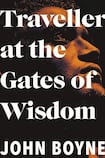
John Boyne’s lively and overreaching new novel begins with King Herod’s Massacre of the Innocents and ends in the future. Its artist narrator lives the normal lifespan of a human, but over two millennia. Sometimes he paints boats in Egypt, embroiders in South Korea or writes novels from Scottish jails.
The perspective of A Traveller at the Gates of Wisdom shifts a few decades with each chapter, its story and most of the particulars being taken up in relay by a different man in a different country. But each has a violent older brother, a protective and jealous sister who would have made a great warrior had it not been for her gender, and a handsome, clever adopted cousin who will cause the narrator great pain and drive him to seek vengeance.
The reader doesn’t suffer much whiplash, chapter to chapter, adapting to the new configurations, and picks up the knack quickly. Along with the echoes of family history, incidents thread their way through each time-frame. Offputting dignitaries reappear under different animal monikers. Lullabies, natural disasters and certain artefacts become motifs.
“I know this much,” the narrator says during one of his 50 lifetimes, “the things that surround us may change, but our emotions will always remain the same. A man who lost his beloved wife a thousand years ago suffered the same grief that I felt when I lost mine, no more and no less.”
Our artist narrator Forrest Gumps his way through history, having a hand in the creation of the Buddha of Bamiyan mountain, the Book of Kells and the Sistine Ceiling. There is the Black Death in northern Europe, rope tricks in Indian markets and Maoris performing the Haka for white colonists. The brief experience of being in any of Boyne’s settings is a sort of tourism, while the broad experiences of the characters reinforce the book’s artistic message of universality.
Historical integrity
To further establish this, Boyne destabilises the historical integrity of his set pieces. Pre-conquest Central Americans know European myths and pre-conquest South Americans have Spanish names. An Irish monk circa AD 800 quotes Liam Neeson in Taken. A dressmaker at the court of Attila the Hun makes dyes out of items from the Nintendo game Zelda: Breath of the Wild: “for the red I had used for Abrila’s dress, I employed spicy pepper, the tail of the red lizalfos and four Hylian shrooms.”
This would make for a nice middle-brow fable – funny when its humour is less obvious, gripping and readable where not choked by unsubtle technique – and that would be that. But A Traveller has what one of its historical celebrity walk-ons would call “vaulting ambition”. Boyne’s 12th novel for adults feels influenced by Susan Barker’s The Incarnations or something by David Mitchell, but the scope is yet wider.
The narrators are themselves responsible for some of the finest artworks ever created, yet display scant artistic sensibility as storytellers. The best-selling author, speaking through his various conduits, has a serially unmusical voice. “‘So – forgive me – but what is the King of Scotland doing in an inn in the Low Countries?’” (In an inn in?!)
Besides the truism that human experiences and feelings are immutable, cursory work seems to have been put into imagining how a person from this or that period might have experienced or felt them, beyond lip-service paid to shifting attitudes about gender, sexuality, slavery and colonialism. The texture of the past is evoked almost exclusively through heightened formality and long-winded redundancy.
Lack of brevity
Instead of killing, characters are “engaged in sanguineous misadventures”. Unless might be swapped for “lest”, face for “visage”. A Viking berserker rips someone “limb from limb in a great fury of bellicose antagonism”. To lose one’s virginity is “to commit the act that defines the border between childhood and adulthood”. As if brevity was a future invention to which Gauls, Jin Dynasty Chinese or even the Romans themselves didn’t also have recourse.
Without the precision and attention to language that was also a hallmark of such formality in speakers from previous ages, we are left simply with laboured speech. Good old-fashioned historicalese. It’s hard even to get behind a well-meaning, spirited pastiche set in Shakespeare’s London (“verily”, “sooth”, etc). The characters themselves don’t seem to know what they mean: “‘It is a play,’ I replied. ‘No more, no less than that. But it has, I hope, a deal of excitement and adventure within its scenery.’”
Making our way, finally, to the present day, we realise that this prose is for keeps. An American in 2016, awaiting the election result, misguidedly looks forward to Trump being “despatched back to that gaudy monument to bad taste that he’d constructed on Fifth Avenue, where he could blind himself with his grotesque golden pillars”.
I know this much: things that surround characters may change, but bad writing stays the same.









